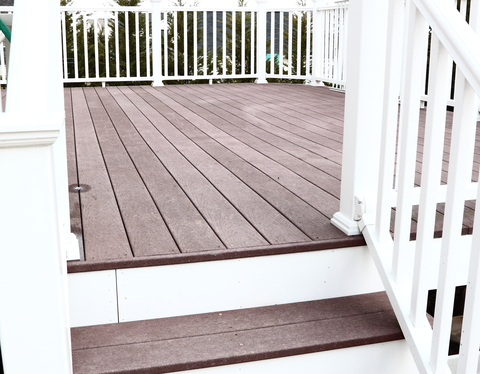Adding a new deck to your home increases the value of the property, boosts its aesthetic appeal and expands your family’s living spaces. Composite decking is a durable and environmentally friendly option that provides a good return on your home improvement investment.

Cost of Composite Decking
Decking costs vary by region, material type and the complexity of your deck design. For example, if you plan to incorporate railings, benches, a spa enclosure or a pergola in your new deck, your cost will be higher than average. Currently, the average price for basic composite decking material ranges between $6 and $8 per square foot(1).
Various manufacturers price their composite decking differently. Less costly materials are hollow-core or cellular in construction while higher-end materials are solid throughout. Some manufacturers make their boards wider for added stiffness and stability, which raises the cost. Several companies produce more than one product line, each priced differently.
Comparing Decking Materials
EPA’s Decking Alternatives Cost Calculator provides a reasonable cost comparison of various decking materials. The following totals reflect the average price for a completed 20 x 30 foot deck as of 2006:
• $4,029: pressure treated pine
• $5,121: recycled plastic/wood composite
• $5,745: cedar/redwood
The Average 10-Year Cost of Composite Decking
According to EPA, the 10-year cost of a composite deck is nearly the same as its initial cost because maintenance is minimal. In contrast, the 10-year cost of a redwood deck is almost double its original price due to high maintenance. Similarly, the 10-year price of a pine deck is $9,921 compared to its original price tag of $4,029.
Therefore, when you cost out your decking options over the longer term, you see the advantage of putting a bit more money into low maintenance composite materials. Additionally, your composite deck lasts longer — up to 50 years. In comparison, well-maintained wood decks average only about 20 years before they need to be replaced.
Factors That Raise the Price of Your Composite Deck
Besides the size of your deck, the shape, elevation and the number of built-in features affect the cost. If you plan to take the best advantage of standard lengths of composite lumber, your cost per square foot will be less than if your design calls for dimensions that produce more waste. Lengths may vary according to the product you plan to use, but in general, 8′, 10’, 12’ and 16’ are the standard lengths for decking lumber.
If your design calls for curves or cutouts, additional installation costs will add to the ultimate price. However, since your composite deck is likely to outlast your tenure in your home, you may believe it worthwhile to pay for custom work that adds to its beauty.
Also, if your deck is elevated above the ground or built on terraced levels, your financial outlay will be higher than the cost of a deck on level ground. If your property requires excavation to accommodate a deck, be sure to include that expense in your calculations.
Railings, steps, planters, benches, trellises, gazebos, hot tub platforms and other custom add-ons further raise your initial deck cost. You may choose to include some essential features, such as steps, during construction but to add others, like benches, later as your budget allows.

Additional Benefits of Composite Decking
Wood and plastic composite lumber provides a number of benefits over natural wood products. Composites are:
• Non-toxic
• Guaranteed not to rot, crack or splinter
• Stain resistant
• Resistant to salt water and fresh water damage
• Permanently stained and sealed
• Mildew and mold resistant
• Insect proof
• Resistant to ultraviolet rays
• Washable and impervious to chemical damage
In addition, composite decking is environmentally friendly. It is made from recycled wood, so it does not impact living forests. It contains waste plastic that would otherwise end up in landfills. Most composites contain no chemicals that could affect rainwater runoff.
Some homeowners prefer the look and feel of wood decking to composite materials. However, manufactures are currently producing more natural-looking composites in more color than ever. Given the low maintenance and longevity of composite materials, they represent a wise home improvement investment.
Tags: average cost, composite decking, deck, trex
